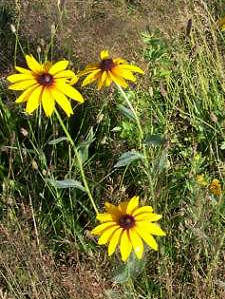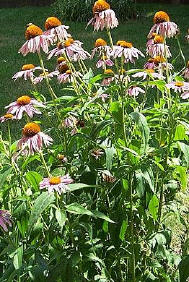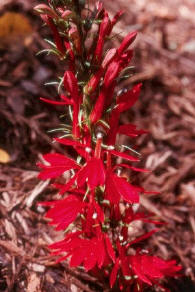|
Tips on Summer Care of Perennial Gardens
Phyllis Heuerman
Frederick County Master Gardener Program
Although many people are not aware of this, one of the best things you can do to keep your perennial garden looking well groomed all summer is to prune the plants regularly. This has been especially important this year when many plants
grew up to twice their normal size due to all of the rain we had this spring.
Pruning can mean anything from deadheading, which is removing the spent flower heads, to cutting plants all the way down to the ground. Pruning can do many things including, extending the bloom period or promoting rebloom, encouraging
lush new growth, reducing plant height, keeping plants in their own space and staggering plant heights and bloom times.
|

Black-eyed Susan
Rudbeckia hirta

Purple Cone Flower
Echinacea purpurea |
I think the single most important type of pruning we can do is to deadhead spent flowers. This often extends the bloom period of the plant by encouraging growth of additional flower buds. How far below the spent flower you prune depends
upon the growth habit of the plant. Look on the stem below the spent flower and see if there are any new flower buds forming. If there are, prune to just above the first flower bud below the dead flower. This works well for Rudbeckia (Black-eyed Susan), Lucanthemum (Shasta
Daisy), Echinacea (Purple Coneflower) and Monarda (Bee Balm). When you see no more flower buds on a stem on these plants, cut the stem to the ground. This will promote lush new growth at the base of the plant. Although you will probably have no additional flowers for the
season, you will have attractive foliage. One more word about Black-eyed Susans and Purple Coneflowers -- their seed heads attract birds. If you are interested in feeding the birds, leave some of the spent flowers on the plant at the end of the bloom period. Be aware though
that in addition to providing food for the birds, the plants will reseed themselves in your garden if the seed heads fully develop.
Many perennials, like geraniums (not the annual Pelargonium that we call geraniums), and Thread-leaf Coreopsis have fine foliage and small flowers. Rather than removing individual flowers, these plants can be deadheaded by shearing off
the tops after the first bloom. You can actually remove the foliage of these plants to within 4 to 6 inches of the ground if you want to. This shearing helps keep the plants in their place and promotes rebloom.
Daylilies (Hemerocallis) are another perennial that can begin to look straggly in mid summer. Daylilies produce only one cluster of flowers on a stem. You should remove the entire stem once the flowers have finished. On repeat-blooming
daylilies like 'Stella d'Oro' this will encourage rebloom. On daylilies that bloom only once, removing spent flower stems simply improves the appearance of the plant. If the foliage of a daylily begins to look really bad, you can cut it of to within 2 or three inches of the
ground after bloom. This will promote lush new growth.
|

Cardinal Flower
Lobelia cardinalis
|
Some perennials just get too tall for their space, or so tall that they tend to fall over. You can reduce the size of these plants by cutting them back once or twice before they bloom. Although this will delay bloom slightly, you will
generally have shorter plants and more flowers. This technique works well for Bee balm, (Yarrow) Purple Coneflower, and Lobelia cardinalis, among others. The technique is to cut the stems back 3 to 6 inches when flower buds begin to form.
You are probably beginning to get the idea that I think pruning perennials is very important. I want to mention one more type before I close. Some perennials are planted in our gardens specifically for fall color, like Chrysanthemums and
Asters. However, these plants will bloom in mid summer if they are not cut back once or twice in early summer. Generally the plants should be cut back by about one-half to two-thirds when they are 12 to 16 inches tall. Not only will this delay bloom, it will produce more
compact plants with more flowers.
If you want to know more about pruning perennials, I highly recommend the book The Well-Tended Perennial Garden, by Tracy DiSabato-Aust.
Read other articles on gardening techniques
Read other summer related gardening articles
Read other articles by Phyllis Heuerman |